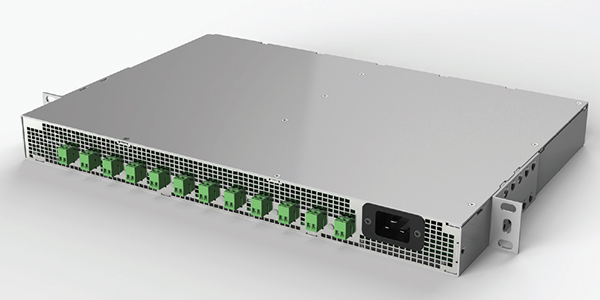For those who need to provide cellular and/or public safety systems inside
An intelligent power system can reside within a passive optical network architecture. Power supply units are housed within IDF rooms, and are connected to devices like remote access units with composite cabling.
their facilities, many manufacturers still rely on singlemode fiber for the signal transport via analog RF over glass (RFoG) technology. Many of these devices require hundreds to thousands of watts of power, and in many cases this power has to be run hundreds or thousands of feet back to the main distribution frame (MDF) rooms or headends, due to centralized power backup requirements. These and other high-power devices such as the TVs, lighting systems, and distributed PoE switches outlined above cannot rely on even the best UTP or PoE systems planned today. When looking at the possible pathway congestion and distance limitations the proliferation of PoE devices foretell, even the latest solutions are limited to 100 watts over 90 meters. Thankfully, we are seeing new technologies as well as evolutions of existing well-known technology rising to fill the gaps.
The NEC seems to agree with the need for new or emerging technology, as the producers of the NEC have started to pay more attention to network powering. While Sections 725 and 830 both cover some “types” of powering, the codes are playing catch-up with the latest devices. Recently, the NEC has taken notice of the levels of power being transported over the relatively small wire gauge typically used in Category 6A and other UTP/FTP cables. A very healthy, and sometimes confusing, debate has ensued, adding to the uncertainty around the newer standard.
One alternative to address the limitations of PoE is Class 2 power, which can service longer distances than traditional PoE. The power level is still less than 100 watts, but the lack of requirement to use Category UTP cable gives designers more flexibility with respect to distance via larger-gauge conductors. If we pair the bandwidth and distance capabilities of singlemode fiber with the ability to use larger-gauge copper conductors, we can far exceed the 90-meter limitations of even the best PoE.
However, there is a more promising alternative. Traditional PoE can now be strengthened by combining the bandwidth and distance advantages of fiber-optic cabling mentioned above with an intelligent power solution enabled by composite cabling. For example, a 75-watt device requiring a minimum operating voltage of 48 VDC over 1100 feet can be powered from a source using 14-AWG cable. If the wire gauge is bigger or the end device requires less than 48 VDC, distances increase even more. Intelligent power technology paired with smaller “micro zones” could power a number of 25-watt PoE devices using a combination of a single small composite fiber and copper cable, combined with short patch cables running to and from the micro zone.
Adding to the promise is the development of new “touch-safe” power under NEC 725 and 830. Using IEC 60950- 21 (Information Technology Equipment – Safety – Part 21: Remote Power Feeding) and IEC 62368-1 (Audio/Video, Information and Communications Technology Equipment – Part 1: Safety Requirements) for guidance, people are developing and deploying technologies that far exceed thousands of watts over thousands of feet of the same composite fiber and copper cable.
It is an exciting time for network designers, with the long-respected bandwidth/distance/power boundaries for Layer 1 in our networks crashing down. We are now able to deliver services to customers where, when, and how they want to use them instead of forcing square pegs into round holes. Optical fiber offers unmatched bandwidth and distance advantages and will undoubtedly be a key component in the networks of the future. Combining optical fiber with higher-power solutions via composite cable provides a robust extension to traditional PoE systems, allowing us to bring future-ready bandwidth and power to our devices safely and easily. And perhaps even more exciting is that the “wire-it-once” capability of optical fiber can simplify future upgrades and reduce cost over the lifetime of the network.


